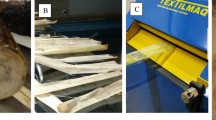Abstract
Three-dimensionally shaped cellulosic objects were produced via a two-step procedure: swelling of softwood pulp (93 % cellulose; 4.5 % hemicellulose; 54 % crystallinity) in DMAc/LiCl followed by moulding. Swollen cellulose pulp in the form of gel was solidified with two different anti-solvents: distilled water and a combination of 2-propanol and deionized water. The solid cellulose material was further moulded in a custom-built prototype mould. The role of the anti-solvent was to solidify the swollen cellulose fibres and prepare mouldable solid specimens. The anti-solvent was chosen based on the following criteria, viz., recoverability, stable chemical reactivity, availability, cost and previous research in the anti-solvent area. The choice of solidification solvent had a great influence on the structure and mechanical properties of the final cellulose material. Results of different characterisation techniques showed that when the cellulose gel was washed with distilled water, it had a significantly higher number of lithium cations (ICP-MS and Raman), amorphous structure (X-ray) and lower mechanical properties (nanoindentation) compared to samples washed with a combination of 2-propanol and deionized water. An increase in viscosity as previously reported and changes in the NMR and IR spectra of DMAc upon LiCl suggested the formation of an ion-dipol complex, where lithium cations reside adjacent to the oxygen of the carbonyl group of DMAc. The formed macrocation [DMAcn + Li]+ was preserved between cellulose chains in cellulose specimens washed with distilled water and had an essential role in the disruption of initial bonds, thus enhancing mouldability. Electron microscopy (FE-SEM) studies showed that the surface of cellulose after mechanochemical treatment was rough with no presence of fibres.








Similar content being viewed by others
Abbreviations
- DMAc:
-
N,N-dimethylacetamide
- FE-SEM:
-
Field emission scanning electron microscope
- ICP-MS:
-
Inductively coupled plasma mass spectroscopy
- RSD:
-
Relative standard deviation
- SD:
-
Standard deviation
- SWDP:
-
Softwood dissolving pulp
- WAXD:
-
Wide angle X-ray diffraction
References
Ciolacu D, Ciolacu F, Popa IV (2011) Amorphous cellulose-structure and characterization. Cellulose Chem Technol 45:13–21
Cuissinat C (2006) Swelling and dissolution mechanisms of native cellulose fibres. PhD dissertation, Ecole Nationale Supérieure des Mines de Paris, Sophia-Antipolis, France
Cuissinat C, Navard P, Heinze T (2008) Swelling and dissolution of cellulose, Part IV: free floating cotton and wood fibres in ionic liquids. Carbohydr Polym 72:590–596
Domsjö (2011) Specification Domsjö cellulose. http://www.domsjoe.com. Accessed 01 Feb 2012
Duchemin BZ, Newman HR, Staiger PM (2007) Phase transformation in microcrystalline cellulose due to partial dissolution. Cellulose 14:311–320. doi:10.1007/s10570-007-9121-4
Haan DR, Rose SH, Lynd LR, van Zyl WH (2007) Hydrolysis and fermentation of amorphous cellulose by recombinant Saccharomyces cerevisiae. Metab Eng 9(1):87–94
Ioelovich M (2008) Cellulose as a nanostructured polymer: a short review. Bioresources 3:1403–1418
Mantanis GI, Young RA, Rowell RM (1995) Swelling of compressed cellulose fiber webs in organic liquids. Cellulose 2:1–22
Navard P, Cuissinat C (2006). Cellulose swelling and dissolution as a tool to study the fiber structure. 7th International symposium alternative cellulose: manufacturing, forming, properties. Rudolstadt, Germany
Nayak NJ, Chen Y, Kim J (2008) Removal of impurities from cellulose films after their regeneration from cellulose dissolved in DMAc/LiCl solvent system. Eng Chem Res 47:1702–1706
Nilsson H, Galland S, Larsson TP, Gamstedt KE, Nishino T, Berglund AL, Iversen T (2010) A non-solvent approach for high-stiffness all-cellulose biocomposites based on pure wood cellulose. Compos Sci Technol 70:1704–1712. doi:10.1016/j.compscitech.2010.06.016
Quintana R, Persenaire O, Bonnaud L, Dubois P (2012) Recent advances in (reactive) melt processing of cellulose acetate and related biodegradable bio-compositions. Polym Chem 3:591–595. doi:10.1039/C1PY00421B
Schroeter J, Felix F (2005) Melting cellulose. Cellulose 12:159–165. doi:10.1007/s10570-004-0344-3
Socrates G (2001) Infrared and Raman characteristic group frequencies, 3rd edn. Wiley, West Sussex
Togawa E, Kondo T (1999) Change of morphological properties in drawing water-swollen cellulose films from organic solutions. A view of molecular orientation in the drawing process. J Polym Sci 37:451–459
Volkert B, Wagenknecht W (2008) Substitution patterns of cellulose ethers- Influence of the synthetic pathway. Macromol Symp 262:97–118
Wadehra IL, Manley J (1965) Recrystallization of amorphous cellulose. J Appl Polym Sci 9:2627–2630
Wei Y, Cheng F (2007) Effect of solvent exchange on the structure and rheological properties of cellulose in LiCl/DMAc. J Appl Polym Sci 106:3624–3630. doi:10.1002/app.26886
Yun S, Chen Y, Nayak NJ, Kim J (2008) Effect of solvent mixture on properties and performance of electro-active paper made with regenerated cellulose. Sens Actuators B: Chem 29:652–658. doi:10.1016/j.snb.2007.09.049
Zhang W, Liang M, Lu C (2007) Morphological and structural development of hardwood cellulose during mechanochemical pretreatment in solid state through pan-milling. Cellulose 14:447–456. doi:10.1007/s10570-9135-y
Zhang X, Wu X, Gao D, Xia K (2012) Bulk cellulose plastic materials from processing cellulose powder using bulk pressure-equal channel angular pressing. Carbohydr Polym 87:2470–2476
Zhorin AV, Kiselev RM, Zelenetskii NA, Rudakova AT (2010) Calorimetric investigation of some polysaccharides subjected to high-pressure plastic deformation. Polym Sci 52:398–406. doi:10.1134/s0565545x10040085
Acknowledgments
This work is part of the Future Biorefinery (FuBio) project, funded by TEKES and coordinated by the Finnish Bioeconomy Cluster (FIBIC).
Author information
Authors and Affiliations
Corresponding author
Rights and permissions
About this article
Cite this article
Obradovic, J., Wondraczek, H., Fardim, P. et al. Preparation of three-dimensional cellulose objects previously swollen in a DMAc/LiCl solvent system. Cellulose 21, 4029–4038 (2014). https://doi.org/10.1007/s10570-014-0403-3
Received:
Accepted:
Published:
Issue Date:
DOI: https://doi.org/10.1007/s10570-014-0403-3




